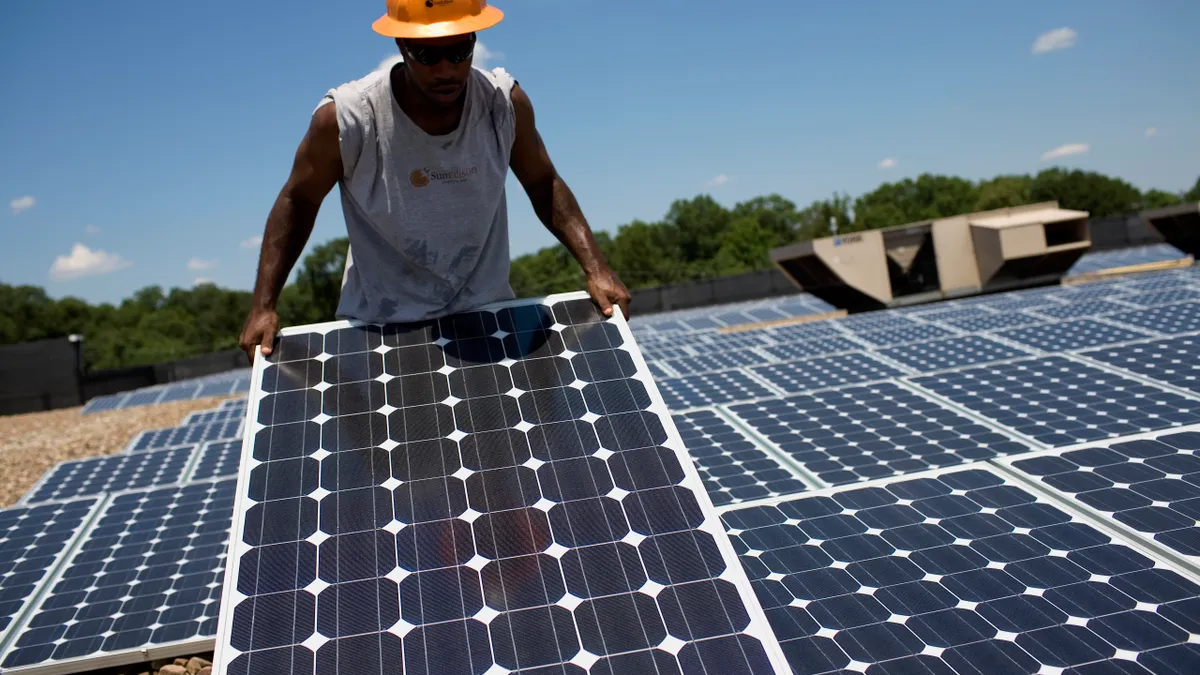Dive Brief:
- The efficiency sector provides more jobs than any other in the U.S. energy industry but employment has not returned to pre-pandemic levels, according to a report released Tuesday by nonpartisan business group E2 and clean energy nonprofit E4TheFuture.
- The sector now employs more than 2.1 million people, according to the annual Energy Efficiency Jobs in America report, but that figure shrunk 13.5% in 2020 because of COVID-19 and the pandemic's economic impacts.
- The report comes as lawmakers consider infrastructure and budget reconciliation measures that include billions in funding for efficiency, which experts say could boost the sector's employment and reduce U.S. carbon emissions. "What I'm seeing in Congress is a growing acceptance ... that we have to act," Rep. Peter Welch, D-Vt., said at an event introducing the efficiency employment report.
Dive Insight:
Welch sounded an optimistic tone for energy and efficiency policies that may ultimately be included in the infrastructure and budget reconciliation measures now being debated on Capitol Hill.
Specifically, Welch called out two pieces of bipartisan legislation he believes will be included in the final reconciliation bill: the HOPE for HOMES Act of 2021, which includes rebates for efficiency improvements, and the Federal Building Clean Jobs Act to upgrade government facilities.
"I'm really getting hopeful" for climate policy and measures to fund efficiency, he said. There is a growing awareness among lawmakers of the necessity to act, he said, combined with an appreciation for policies that can be affordable and create jobs, that "gives us some winds at our back."
Welch said he was on a Zoom call Monday with President Joe Biden and Vice President Kamala Harris discussing reconciliation negotiations and their agenda. They were "very realistic," said Welch, about both the need for action and the headwinds the agenda faces.
The Biden Administration has called for decarbonizing the power sector by 2035, with much of that achieved through the Build Back Better agenda. However, Sens. Joe Manchin, D-W. Va., and Kyrsten Sinema, D-Ariz., have balked at the $3.5 trillion budget reconciliation price tag.
"There was a realistic discussion about the urgency of Democrats making the painful decisions we have to," said Welch. "There was not a discussion of specific programs that would come or go," but there was a general understanding the final budget number will need to come down.
In some instances, budgets for some policies may need to be shrunk or program timelines reduced, in order "to get embedded the policies we need," said Welch. But with climate measures, there is an acknowledgement among Democrats "anything we do has to be done, and even if it isn't paid for."
Efficiency investments can help to create good paying, local jobs "with the right policy support," said Welch. “Helping the energy efficiency industry fully recover from the pandemic can be a win for green jobs and the environment."
The E2 and E4TheFuture employment report highlighted the sector's importance and challenges.
Pre-pandemic, the efficiency sector was growing at an annual rate of about 3%. COVID-19 ultimately wiped out almost 322,000 jobs in the sector.
Efficiency jobs, which include some manufacturing and construction workers, total about 2.1 million compared with about 972,000 in the fossil fuel industry, 1.18 million in traditional transmission and distribution jobs, and about 668,000 in clean energy, according to the report.
"Decarbonization drives employment," said Phil Jordan, vice president and principal researcher at BW Research Partnership, the firm which completed the report. And investments in saving energy have the "opportunity to drive equity and create wealth."
Even after the pandemic's initial hit, efficiency employment began to recover in the summer and fall of 2020, Jordan said, as utility efficiency programs reopened and construction restarted. But with winter, job growth in construction and buildings fell off, he said.
"And since over half of energy efficiency jobs have to do with construction and the trades, efficiency employment growth stalled, as well. Supply chain issues exacerbated the problem,” Jordan said in a statement on the report.
That highlights the need for federal support for efficiency programs, said E2 Executive Director Bob Keefe. He said the Build Back Better proposal advanced by the House Energy and Commerce Committee included $18 billion for residential efficiency upgrades and $17 billion to improve federal buildings.
"There is no better policy for energy efficiency, for clean energy and the climate," than the Build Back Better act and the infrastructure bill, said Keefe. "Energy efficiency is a big and important part of our economy ... We create more of these jobs with good public policy. "















